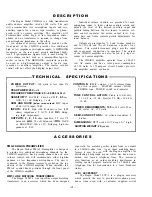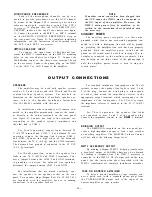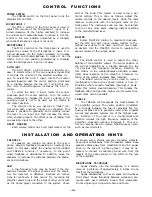
and the Bogen amplifier. The LVP-1 may also be used
as
a remote
volume control in conjunction with the
Model RVC-1 remote volume control.
ing a dual-stylus turnover cartridge is included with
record player.
LK-IO CONTROL GUARD LOCKING PLATE
RVC-I REMOTE VOLUME CONTROL
The Bogen Model LK-10 control guard locking
The Bogen Model RVC-1 accessory permits the
plate is designed to prevent unauthorized tampering
amplifier to provide remote volume control when used with the controls of amplifier. It comes complete with
in conjunction with LVP-1 accessory. two sets of keys. The key cannot be removed when
MODEL LPC-4 PHONO PLAYER TOP
the lock is in open position.
Model LPC-4 is a complete four-speed phono-
RPK-27 RACK PANEL
player designed to be mounted directly on top of the
The Bogen Model RPK-27 rack panel kit is de-
amplifier. The unit comes complete with all necessary
signed to mount the CHSlOO amplifier (with or with-
hardware, and can be easily installed and connected
out the PMA-2 preamplifier) in a standard 19”
x
to amplifier with only a screwdriver. A tone arm hous-
rack. The rack panel is finished in gray enamel.
I N S T A L L A T I O N
UNPACKING
power cables.
Inspect the shipping container and amplifier for
indications of improper handling. The amplifier was
carefully checked before leaving factory. If the unit
has been damaged, make an immediate claim to the
dealer
or
distributor from whom it was purchased. If
the amplifier was shipped to you, notify the trans-
portation company without delay and place your claim.
POWER AND GROUNDlNG
CONNECTIONS BETWEEN COMPONENTS
For high-impedance inputs, use single-conductor,
low-capacity shielded wire for connecting the record
player, tape recorder, and other components to the
amplifier. Keep leads under ten feet in length.
For low-impedance microphone inputs, use single-
conductor shielded wire, in lengths from
50
to 500
feet depending on the characteristics of the micro-
phone.
The amplifier is furnished with an AC line cord
terminated in a three-prong plug. Plug the line cord
into a three-wire grounded outlet providing a nominal
120-volt, 50-60 cycle power source. This will ground
the amplifier as well as supply power to it.
It is advisable to ground the amplifier. Therefore,
if a three-wire outlet is not available, an adapter such
as Leviton No. 5017 should be used to convert a stand-
ard two-wire outlet for use with three-wire plugs. The
adapter is provided with a grounding pigtail which
should be connected to the screw holding the wall plate
to the receptacle, as shown in figure 1.
Speakers may be connected with standard flex-
ible line cord (zip-cord), and up to 100 feet of cable
may be used without appreciable loss.
Make certain that all input cables are kept away
from speakers cables, power cables, and power trans-
formers, and that speaker cables are kept away from
I n s o m e a r e a s , t h e wall plate s c r e w i s n o t
g r o u n d e d . In this case it will be necessary to
connect a grounding wire between the GND ter
minal on the rear chassis of the amplifier and a
water or steam pipe.
NOTE
I N P U T C O N N E C T I O N S
MICROPHONES
Two microphones may be connected to the am-
plifier, and either or both may be used simultaneously.
Either high or low-impedance microphones may be
used. The amplifier is shipped with an adaptor in the
microphone receptacles, which permits high-impedance
microphone inputs either from a phone plug or from
a standard MClF microphone connector.
Figure 1 - Grounding Line Cord Adapter
HI Z: Connect a high-impedance microphone (10,000
ohms or more) to the MIC 1 HI Z receptacle on the
rear panel of the amplifiet (see figure 2). Connect a
second high-impedance microphone to the receptacle
marked MIC 2 HI Z. Use a single-conductor shielded
cable, terminating either in a phone plug or a standard
microphone connector (Amphenol 75-MClF or equiv-
alent). Remove the adaptor from the microphone re-
ceptacle when the phone plug is used. The cable
length from the microphone to the amplifier should be
kept under 10 feet.
LO Z:
Connect low-impedance microphones (600 ohms
or less) to the LO Z terminal strip on the rear panel
(see figure 2). Use a single-conductor shielded cable.
The conductor is connected to the MIC 1 terminal and
the shield to GND. Connect a second low-impedance
microphone to the terminal strip in the same manner,
with the high side of the cable to the MIC 2 terminal
-3-
Summary of Contents for CHS100
Page 8: ......


























